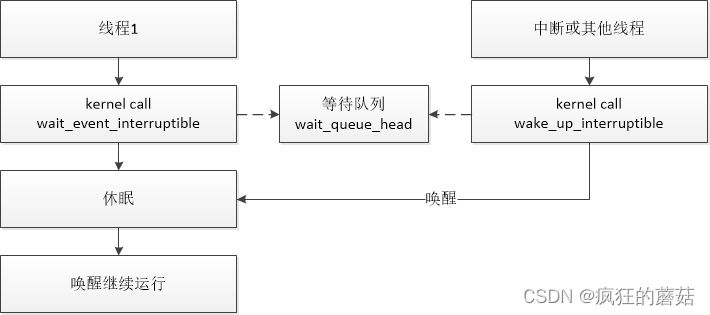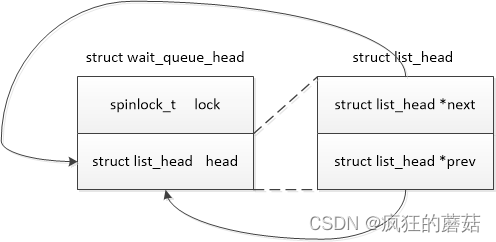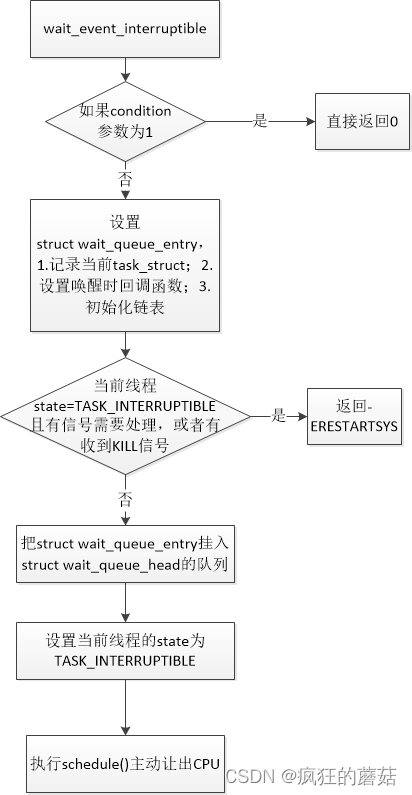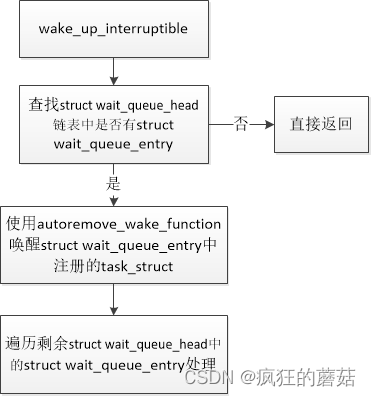Linux内核wait |
您所在的位置:网站首页 › interruptible 翻译 › Linux内核wait |
Linux内核wait
|
功能简介
Linux内核等待队列是内核的一套事件唤醒机制,一般用于内核中断与线程的唤醒休眠,内核线程之间的唤醒休眠。常用接口是唤醒:wake_up_interruptible,等待休眠:wait_event_interruptible。
图1:等待队列常见使用流程 图1所示为等待队列常见使用流程,例如图中线程1通过系统调用进入内核,后调用wake_up_interruptible等待唤醒事件,当事件不满足条件时,线程1进入休眠状态。中断或其他线程任务事件满足条件时,调用wait_event_interruptible,唤醒等待在wait_queue_head上的线程1。其中等待队列wait_queue_head是内核中的一个struct,需要在使用时进行初始化。 内核中使用步骤 初始化声明一个struct wait_queue_head变量test,并初始化: DECLARE_WAIT_QUEUE_HEAD test; 再声明一个条件变量int condition = 0; DECLARE_WAIT_QUEUE_HEAD的宏定义在include/linux/wait.h中 线程等待事件线程的内核态调用 wait_event_interruptible(test,condition); 当condition为非0时,立马返回,不会休眠,当condition为0时,线程加入等待队列链表中,然后线程进入休眠状态。 事件产生,唤醒等待线程当某一个事件状态满足要求,如某一个中断触发时,内核代码执行: wake_up_interruptible(&test); 唤醒之前休眠等待在test等待队列中的线程。 内核中数据结构在include/linux/wait.h中,有struct wait_queue_entry和struct wait_queue_entry。 /* * A single wait-queue entry structure: */ struct wait_queue_entry { unsigned int flags; void *private; wait_queue_func_t func; struct list_head entry; }; struct wait_queue_head { spinlock_t lock; struct list_head head; }; typedef struct wait_queue_head wait_queue_head_t;
图2:初始化struct wait_queue_head后的数据结构图
图3:添加一个线程到等待队列后的数据结构图 如图3所示为添加一个线程到等待队列后的数据结构图,每添加一个线程到队列中,反应到数据结构中,就是struct wait_queue_head中添加了一个struct wait_queue_entry,其中void *private记录线程的task_struct,func记录当唤醒等待队列中的线程时,使用的回调函数。接着上面的使用示例,每当不同的线程调用wait_event_interruptible(test,condition)时,就会在上面链表中添加一个struct wait_queue_entry。唤醒时,会遍历链表,逐个唤醒。 内核中关键函数实现 wait_event_interruptible
图4 wait_event_interruptible 代码流程图
图5 任务1、任务2 调用wait_event_interruptible休眠后链表示意图 在include/linux/wait.h中 #define wait_event_interruptible(wq_head, condition) \ ({ \ int __ret = 0; \ might_sleep(); \ if (!(condition)) \ __ret = __wait_event_interruptible(wq_head, condition); \ __ret; \ })当condition为0时,进入__wait_event_interruptible流程,线程进入休眠 当condition为1时,线程直接返回0,不休眠 #define __wait_event_interruptible(wq_head, condition) \ ___wait_event(wq_head, condition, TASK_INTERRUPTIBLE, 0, 0, \ schedule())创建一个struct wait_queue_entry __wq_entry结构, 记录线程信息,挂入struct wait_queue_head中的链表中,然后执行schedule,释放cpu给其他线程。 #define ___wait_event(wq_head, condition, state, exclusive, ret, cmd) \ ({ \ __label__ __out; \ struct wait_queue_entry __wq_entry; \ long __ret = ret; /* explicit shadow */ \ \ init_wait_entry(&__wq_entry, exclusive ? WQ_FLAG_EXCLUSIVE : 0); \ for (;;) { \ long __int = prepare_to_wait_event(&wq_head, &__wq_entry, state);\ \ if (condition) \ break; \ \ if (___wait_is_interruptible(state) && __int) { \ __ret = __int; \ goto __out; \ } \ \ cmd; \ } \ finish_wait(&wq_head, &__wq_entry); \ __out: __ret; \ })kernel/sched/wait.c void init_wait_entry(struct wait_queue_entry *wq_entry, int flags) { wq_entry->flags = flags; wq_entry->private = current; wq_entry->func = autoremove_wake_function; INIT_LIST_HEAD(&wq_entry->entry); } EXPORT_SYMBOL(init_wait_entry);上面的函数设置了等待在队列的进程,设置了唤醒等待队列时的回调函数 autoremove_wake_function。 long prepare_to_wait_event(struct wait_queue_head *wq_head, struct wait_queue_entry *wq_entry, int state) { unsigned long flags; long ret = 0; spin_lock_irqsave(&wq_head->lock, flags); /* 如果state == TASK_INTERRUPTIBLE ,且任务中有信号需要处理,或者任务有收到KILL信号 这时,返回-ERESTARTSYS ,不需要被唤醒 */ if (unlikely(signal_pending_state(state, current))) { /* * Exclusive waiter must not fail if it was selected by wakeup, * it should "consume" the condition we were waiting for. * * The caller will recheck the condition and return success if * we were already woken up, we can not miss the event because * wakeup locks/unlocks the same wq_head->lock. * * But we need to ensure that set-condition + wakeup after that * can't see us, it should wake up another exclusive waiter if * we fail. */ list_del_init(&wq_entry->entry); ret = -ERESTARTSYS; } else { /*把wq_entry 加入到wq_head 的链表中*/ if (list_empty(&wq_entry->entry)) { if (wq_entry->flags & WQ_FLAG_EXCLUSIVE) __add_wait_queue_entry_tail(wq_head, wq_entry); else __add_wait_queue(wq_head, wq_entry); } /*设置当前进程的*/ set_current_state(state); } spin_unlock_irqrestore(&wq_head->lock, flags); return ret; } EXPORT_SYMBOL(prepare_to_wait_event); wake_up_interruptible
图6 wake_up_interruptible流程图 include/linux/wait.h #define wake_up_interruptible(x) __wake_up(x, TASK_INTERRUPTIBLE, 1, NULL)kernel/sched/wait.c void __wake_up(struct wait_queue_head *wq_head, unsigned int mode, int nr_exclusive, void *key) { __wake_up_common_lock(wq_head, mode, nr_exclusive, 0, key); } EXPORT_SYMBOL(__wake_up); static int __wake_up_common(struct wait_queue_head *wq_head, unsigned int mode, int nr_exclusive, int wake_flags, void *key, wait_queue_entry_t *bookmark) { wait_queue_entry_t *curr, *next; int cnt = 0; if (bookmark && (bookmark->flags & WQ_FLAG_BOOKMARK)) { curr = list_next_entry(bookmark, entry); list_del(&bookmark->entry); bookmark->flags = 0; } else curr = list_first_entry(&wq_head->head, wait_queue_entry_t, entry); if (&curr->entry == &wq_head->head) return nr_exclusive; list_for_each_entry_safe_from(curr, next, &wq_head->head, entry) { unsigned flags = curr->flags; int ret; if (flags & WQ_FLAG_BOOKMARK) continue; ret = curr->func(curr, mode, wake_flags, key); if (ret < 0) break; if (ret && (flags & WQ_FLAG_EXCLUSIVE) && !--nr_exclusive) break; if (bookmark && (++cnt > WAITQUEUE_WALK_BREAK_CNT) && (&next->entry != &wq_head->head)) { bookmark->flags = WQ_FLAG_BOOKMARK; list_add_tail(&bookmark->entry, &next->entry); break; } } return nr_exclusive; } int autoremove_wake_function(struct wait_queue_entry *wq_entry, unsigned mode, int sync, void *key) { int ret = default_wake_function(wq_entry, mode, sync, key); if (ret) list_del_init(&wq_entry->entry); return ret; } EXPORT_SYMBOL(autoremove_wake_function);kernel/sched/core.c int default_wake_function(wait_queue_entry_t *curr, unsigned mode, int wake_flags, void *key) { return try_to_wake_up(curr->private, mode, wake_flags); } EXPORT_SYMBOL(default_wake_function);主要的唤醒流程在__wake_up_common函数中 遍历struct wait_queue_head的链表中链入的struct wait_queue_entry,并执行等待队列的回调函数:autoremove_wake_function autoremove_wake_function中调用try_to_wake_up唤醒struct wait_queue_entry中记录的task_struct,如果成功唤醒了线程,那么同时删除节点。如果没有成功唤醒线程,则不删除节点,这样下次调用时还会再唤醒一次。 自问自答1. 如果wait_event_interruptible(test,condition)中,condition一直为1会怎么样? 答:调用次接口的线程会立马返回不会休眠,如果线程中是死循环调用,则会CPU占用率高 2. 如果两个线程调用wait_event_interruptible(test,condition)阻塞休眠,一个中断调用wake_up_interruptible(test)并设置condition为1,可以唤醒两个线程吗? 答:可以,因为在wake_up_interruptible中会遍历注册到test等待队列中的任务信息,并唤醒。 3. 如果两个线程调用wait_event_interruptible(test,condition)阻塞休眠,一个中断调用wake_up_interruptible(test)但是并没有设置condition为1,会怎么样? 答:两个线程会继续休眠等待。 4. 业务模型为:线程1在循环中调用wait_event_interruptible(test,condition)休眠等待,中断来了后使用wake_up_interruptible(test)并设置condition为1,唤醒线程1,继续执行循环,当怀疑中断来了后,没有唤醒线程1,怎么排查? 答:(1)确定中断确实来了 (2)确定线程1确实没有被唤醒 (3)排查CPU占用,是不是CPU太忙了,导致线程1虽然被唤醒但是没执行 (4)添加定位代码:当中断来时,检查test struct wait_queue_head中是否有等待的struct wait_queue_entry,以及等待的task_struct的state是否处于TASK_INTERRUPTIBLE,pid是否符合预期,如果不是,说明调用wait_event_interruptible的线程存在问题,需要排查 |
【本文地址】
今日新闻 |
推荐新闻 |





